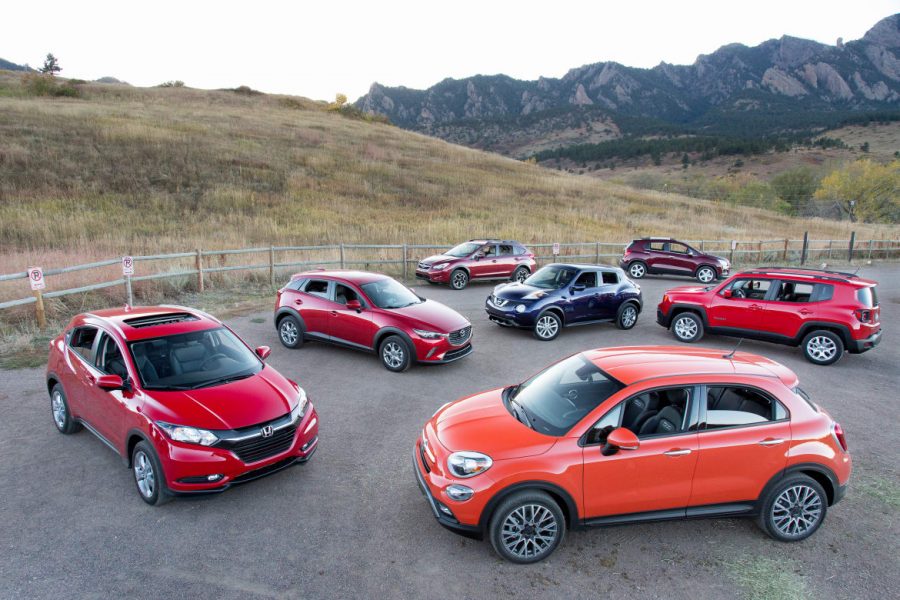Subcompact SUVs gain popularity in U.S. market
May 15, 2019
Subcompact crossovers and SUVs (sport utility vehicle) are the new contenders that have recently infatuated the domestic auto market.
The rising popularity and demand for the near Swiss Army knife capability and potato-like shape they display, has seen a fast and steady rise in purchases in recent years.
What makes these cars so appealing in the first place?
They feature stylish sporty body lines and smaller engine sizes, which allow for decent fuel economy. They also offer the stability of an SUV, while being built on the same platform as most of their sedan counterparts.
When held up against sedans, subcompact crossovers offer a higher driving position with better head clearance. They also provide almost double the cargo space by removing the tapered roof line.
More importantly, taller and stiffer suspension allows for a smoother driving experience when traveling on rough roads or highways.
Settling in somewhere between a car and a full-size SUV, many wonder who compact crossovers were actually designed for?
With younger first-time car buyers living in dense urban areas, it’s important that all available space is maximized.
To suit this demographic, these vehicles offer taller and narrower bodies and a shorter wheelbase.
These cars appeal to a broader set of car buyers who will give them the cargo space generally provided by an SUV and the agility and performance of a sedan.
The behavior of younger car buyers also plays a major role in marketing. Most want an all-purpose vehicle as their first car with enough space to drive a future family around if necessary.
Many older buyers are just as interested in the compact crossovers because subcompact models opt for a one-size-fits-all design to better suit a variety of drivers’ needs.
Automakers introducing a subcompact crossover model place them in competition against other companies that jumped on the bandwagon. Offering a cheaper alternative to their mid-size and full-size SUVs was too lucrative to pass on.
Due to the high saturation of crossovers and SUVs in the domestic market, many automakers such as Ford and General Motors have phased out or shut down sedan production.
Today, many companies focus completely on producing larger vehicles.
One route Ford took was to discontinue their Focus hatchback and introduce their taller, sportier subcompact SUV, the EcoSport.
The largest drawback to owning a traditional SUV is its size.
Its long and wide build requires a much larger engine, which needs more gas just power itself. Poor aerodynamics don’t help.
Because it’s taller, there’s a higher center of gravity, which increases rollover possibilities during a collision.
The subcompact crossover’s origins can be traced back to the 1950s. When World War II was over, gas rationing ended and Americans began to rapidly buy cars.
The construction of the interstate highway system had wide and flat roads that reached the corners of the country. Highway construction led automakers to design a vehicle that could fit a family comfortably while hugging the road to maximize profit.
Hence, the station wagon was born.
It was essentially a sedan that had an elongated roof line and wheelbase for extra cargo space to fit luggage or a third row of seats.
Fast-forward to the 1970s, which saw Chevrolet create the Blazer, a popular gas guzzling SUV. However, at the time the worldwide oil market was in crisis and gas rationing was in place in the U.S.
Americans soon turned to the smaller more efficient Japanese produced cars.
Into the 1990s, Honda created the CR-V alongside the Toyota Rav4, which saw major popularity in the states for its efficiency and capability.
This sparked an evolution that paved the way for subcompact crossovers giving consumers sporty handling while maintaining space for the family.
Automakers adapted to consumer interests to stay relevant and gave subcompact crossovers and small SUVs the best of both worlds in one car.
This happened without forcing buyers to settle on a specific body type to get the full practicality and performance that limited options once required.
Just two decades ago, it was one or the other because their target buyers were on opposite ends of the spectrum.













